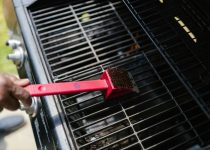How Long Does It Take to Rotisserie a Beef Roast
Ever wondered how to achieve that perfect rotisserie beef roast, like a culinary maestro? You're in luck.
Rotisserie cooking is a time-honored method that infuses your beef roast with unparalleled flavor and juiciness.
But how long does it take to achieve that mouthwatering result? You're about to master the art of rotisserie cooking, from selecting the ideal cut of beef to testing for the perfect doneness.
Get ready to elevate your culinary skills to the next level as we delve into the precise timing required to achieve a succulent, perfectly rotisserie-cooked beef roast.
Key Takeaways
- Choosing a well-marbled chuck or sirloin roast is ideal for maximum tenderness and flavor.
- Preparing the beef roast properly by seasoning, trussing, and securely fastening it onto the spit ensures even cooking.
- Preheating the rotisserie grill and maintaining a consistent temperature throughout the cooking process is crucial for a delicious roast.
- Following cooking time guidelines based on the weight of the roast and using a meat thermometer to check the internal temperature will help achieve the desired level of doneness.
Selecting the Right Beef Roast
When selecting the right beef roast for rotisserie cooking, consider choosing a well-marbled chuck or sirloin roast for maximum tenderness and flavor. These beef cuts are ideal for rotisserie cooking due to their marbling, which helps keep the meat moist and flavorful during the extended cooking time. Additionally, the marbling in these cuts adds richness and depth to the flavor profile of the roast as it rotates and cooks.
In terms of cooking methods, rotisserie cooking involves the meat being skewered on a spit and slowly rotated over a heat source. This method allows the beef roast to cook evenly on all sides, resulting in a beautifully caramelized exterior and a juicy, tender interior. The constant rotation ensures that the natural juices of the meat are distributed throughout, enhancing its succulence and taste.
Understanding the characteristics of different beef cuts and their compatibility with specific cooking methods is crucial for achieving the desired outcome. By selecting a well-marbled chuck or sirloin roast and utilizing the rotisserie cooking method, you can elevate the tenderness and flavor of the beef roast to create a truly exceptional dining experience.
Preparing the Rotisserie Setup
To prepare the rotisserie setup, you'll need to gather the necessary equipment and tools, such as the rotisserie attachment and a meat thermometer.
Next, you'll want to properly prepare the beef roast by seasoning it and trussing it with kitchen twine to ensure even cooking.
Rotisserie Equipment and Tools
You'll need a set of sturdy, heat-resistant gloves when setting up your rotisserie, as handling hot metal is a significant part of the process.
To ensure your rotisserie equipment is in top condition and your cooking goes smoothly, consider the following:
- Rotisserie Maintenance and Cleaning
- Regularly clean the rotisserie spit and forks to prevent buildup and ensure even cooking.
- Check for any signs of wear and tear on the rotisserie motor and replace any damaged parts promptly.
- Lubricate moving parts to keep the rotisserie functioning smoothly.
- Rotisserie Cooking Techniques and Tips
- Truss the meat properly to ensure even cooking and a uniform shape.
- Preheat the rotisserie before adding the meat for more consistent results.
- Use a drip pan to catch any juices and prevent flare-ups.
Preparing the Beef Roast
To prepare the beef roast for the rotisserie setup, ensure that the meat is securely fastened onto the spit with the forks and properly balanced for even cooking.
When choosing the beef roast, consider different cuts such as ribeye, sirloin, or tenderloin, each offering unique textures and flavors. Tailor your cooking preferences to the specific cut to bring out the best taste and tenderness.
Experiment with beef roasting techniques to achieve flavor variations, such as marinating the roast with herbs and spices or using a dry rub for a crusty exterior.
Properly preparing the beef roast sets the stage for a delicious and evenly cooked rotisserie roast, allowing you to master the art of rotisserie beef roasting.
Setting up the Rotisserie
To set up the rotisserie for your beef roast, first ensure the spit is securely in place and the motor is functioning properly. Prior to using the rotisserie, it's crucial to perform regular maintenance and cleaning to ensure safe and efficient operation. Here are some essential tips for setting up the rotisserie:
- Rotisserie Maintenance and Cleaning:
Regularly clean the spit, forks, and drip pan to prevent grease buildup and potential fire hazards.
Inspect the motor, gears, and other mechanical components for wear and tear, and lubricate them as needed to ensure smooth rotation.
- Rotisserie Safety Precautions and Tips:
Always place the rotisserie on a stable, level surface to prevent accidents.
Use heat-resistant gloves when handling hot components and when placing the beef roast on the spit.
Following these maintenance and safety tips will help ensure a successful and safe rotisserie setup for your beef roast.
Seasoning and Marinating the Roast
To achieve a flavorful and juicy rotisserie beef roast, start by marinating the meat for at least 4 hours before cooking. Seasoning techniques are crucial for enhancing the taste of the roast. Consider using a dry rub consisting of salt, pepper, garlic powder, and paprika to create a savory crust on the exterior.
For a more complex flavor profile, experiment with marinating tips such as using a mixture of soy sauce, Worcestershire sauce, and balsamic vinegar to infuse the meat with a rich umami taste.
When choosing marinade options, think about the desired flavor profiles. A classic combination of herbs like rosemary, thyme, and oregano can provide a robust and earthy taste, while a citrus-based marinade with lemon, orange, and lime juice can bring brightness and freshness to the roast. Additionally, incorporating ingredients like honey, brown sugar, or maple syrup can add a touch of sweetness to balance out the savory flavors.
Remember to refrigerate the marinating roast to ensure food safety and optimal flavor penetration. By paying attention to seasoning and marinating, you'll elevate your rotisserie beef roast to a new level of culinary excellence.
Preheating the Rotisserie Grill
Before you start cooking, preheat your rotisserie grill for at least 10 minutes to ensure even cooking and a nicely seared exterior on the beef roast. To achieve mastery in preheating your rotisserie grill, consider the following:
- Rotisserie Grill Maintenance and Cleaning
Regularly clean the grill grates and remove any residue to prevent flare-ups and ensure even heat distribution.
Check the rotisserie motor and spit for any signs of wear or malfunction. Proper maintenance ensures consistent rotation for even cooking.
- Rotisserie Grill Temperature Control
Familiarize yourself with the grill's temperature controls to achieve the desired heat level for rotisserie cooking.
Use an oven thermometer to verify the accuracy of the grill's built-in temperature gauge, ensuring precise heat control.
Rotisserie Cooking Time Guidelines
After preheating your rotisserie grill, begin cooking your beef roast according to the following time guidelines.
| Weight of Beef Roast | Cooking Time | Internal Temperature |
|---|---|---|
| 2-3 lbs | 1-1.5 hours | 135°F-140°F |
| 3-4 lbs | 1.5-2 hours | 135°F-140°F |
| 4-5 lbs | 2-2.5 hours | 135°F-140°F |
| 5-6 lbs | 2.5-3 hours | 135°F-140°F |
To ensure your beef roast is cooked to perfection, it is crucial to exercise precise temperature control. Maintain a consistent temperature of around 325°F-375°F throughout the cooking process for optimal results. This temperature range allows the beef to cook evenly and develop a delectable outer crust while retaining its juicy tenderness. Additionally, proper rotisserie maintenance is essential for achieving the desired cooking times. Regularly clean the rotisserie grill and ensure that all components, including the rotisserie spit and motor, are in good working condition. By adhering to these cooking time guidelines and practicing diligent temperature control and rotisserie maintenance, you can consistently create mouthwatering rotisserie beef roasts that are sure to impress.
Testing for Doneness
You can test for doneness by inserting a meat thermometer into the thickest part of the beef roast. This ensures that the meat has reached the desired internal temperature and is safe to eat.
Here are some key points to consider when testing for doneness:
- Checking Temperature
- Use a meat thermometer to check the internal temperature of the beef roast. For medium-rare, the temperature should be around 135°F (57°C), while for medium, it should be about 145°F (63°C).
- Ensure the thermometer is inserted into the thickest part of the roast without touching any bone, as this can give a false reading.
- Allow the thermometer to settle for a few seconds to get an accurate temperature reading.
Letting the Roast Rest
To achieve optimal juiciness and tenderness, allow the beef roast to rest for at least 15 minutes after removing it from the rotisserie. The resting period is crucial for flavor development and ensuring that the roast remains juicy.
During this time, temperature control is essential as the residual heat continues to gently cook the roast, while the juices redistribute themselves, resulting in a more evenly cooked and flavorful roast.
Additionally, allowing the roast to rest aids in moisture retention, preventing the juices from escaping when the meat is sliced. This ensures that each slice is succulent and packed with flavor.
The resting period also allows the roast to relax, making it easier to carve and resulting in neater slices.
By understanding the significance of letting the roast rest, you can elevate your culinary skills and ensure that every bite is a delight.
Frequently Asked Questions
Can I Use the Same Rotisserie Setup for Beef Roast and Other Meats?
Yes, you can use the same rotisserie setup for beef roast and other meats. However, be mindful of different cooking times for various meats. Rotisserie setups are versatile for cooking a variety of meats.
What Are Some Common Mistakes to Avoid When Seasoning and Marinating a Beef Roast for Rotisserie Cooking?
When seasoning and marinating a beef roast for rotisserie cooking, avoid over-seasoning. Proper marinating techniques involve ensuring the meat is fully coated and allowing enough time for the flavors to infuse. Patience is key.
Is It Necessary to Monitor the Temperature of the Rotisserie Grill While Preheating?
When preheating, monitor the temperature of the rotisserie grill closely. This step is crucial for ensuring even cooking. For different meat varieties, adjusting the temperature accordingly is essential. Properly setting up the rotisserie is key.
Can I Use a Meat Thermometer to Check for Doneness During Rotisserie Cooking?
Yes, you can use a meat thermometer to check for doneness during rotisserie cooking. It's crucial for ensuring the beef roast reaches the desired internal temperature. Proper temperature monitoring and allowing the meat to rest are essential steps.
How Long Should I Let the Beef Roast Rest After It's Done Cooking on the Rotisserie?
After cooking your beef roast on the rotisserie, it's essential to let it rest for about 15-20 minutes. This allows the juices to redistribute, ensuring a moist and flavorful roast. For rotisserie beef, the cooking duration varies based on the size and desired doneness.



